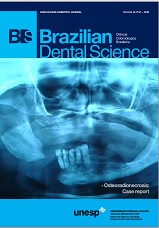Gingival retraction: thickness measurement and comparison of different cords
DOI:
https://doi.org/10.14295/bds.2015.v18i2.1060Abstract
Objective: To measure the thickness of five different brands of gingival retraction cords and verify whether there would be a relationship among the sizes and their numbers and a coherent increasing from the thinnest to the largest thickness. Material and Methods: the following cords were evaluated: Gengiret(G), Retraflex(RF), Retractor(RT), Ultrapack(UP), and Pro Retract(PR). Pieces of the cords were placed beside a metallic ruler and photographed standardly regarding to the distance and light. The measurements of the thickness were performed through imaging software (Adobe Photoshop CS6 - Adobe Systems, San Jose, CA, USA). The obtained data were submitted to statistical analysis (one-way ANOVA and post hoc Sheffé test (p = 0.05)). Results: The number and the thickness of the cords mismatched for most of the brands evaluated. Two brands (UP and PR) showed a thickness increasing that mismatched the size increasing between the thinnest and largest cord. Conclusion: The number assigned to the cords by the manufactures did not correspond to a standard thickness, so that the dentist must observe the risk of using cords from different brands during gingival retraction procedures during techniques requiring more than one retraction cord.
Downloads
Downloads
Additional Files
Published
How to Cite
Issue
Section
License
Brazilian Dental Science uses the Creative Commons (CC-BY 4.0) license, thus preserving the integrity of articles in an open access environment. The journal allows the author to retain publishing rights without restrictions.
=================




























